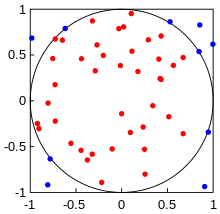The Monte Carlo process
Monte Carlo Simulations in Python

Izzy Weber
Curriculum Manager, DataCamp
Simulation steps
Define the input variables and pick probability distributions for them
Generate inputs by sampling from these distributions
Perform a deterministic calculation of the simulated inputs
Summarize results
Calculating the value of pi
Generate random points $(x, y)$ where $x$ and $y$ are in the interval from -1 to 1.

$$Area_{circle} = \pi $$
$$Area_{square} = 2 \times 2 = 4 $$
$$\frac{Area_{circle}}{Area_{square}} = \frac{\pi}{4} $$
$$\frac{n_{red}}{n_{all}} = \frac{\pi}{4} $$
$$ \pi = 4 \times \frac{n_{red}}{n_{all}}$$
Step 1
Define the input variables and pick probability distributions for them
- Inputs: the individual points represented by $(x, y)$ coordinates
- Probability distributions: $x$ and $y$ follow uniform distributions from negative one to one.
circle_points = 0
square_points = 0
Step 2
Generate inputs by sampling from these distributions
Sample random $x$ and $y$ coordinate values distributed uniformly between -1 and 1:
for i in range(n):
x = random.uniform(-1, 1)
y = random.uniform(-1, 1)
Step 3
Perform deterministic calculation of the simulated inputs
Check whether each point lies within the circle: deterministic for given $x$ and $y$
dist_from_origin = x**2 + y**2
If yes, add the point to circle_points; always add the point to square_points
if dist_from_origin <= 1:
circle_points += 1
square_points += 1
Step 4
Summarize the results to answer questions of interest
After many rounds of simulations, calculate the value of pi!
pi = 4 * circle_points/ square_points
All together now
n = 4000000 circle_points = 0 square_points = 0for i in range(n): x = random.uniform(-1, 1) y = random.uniform(-1, 1) dist_from_origin = x**2 + y**2 if dist_from_origin <= 1: circle_points += 1 square_point += 1pi = 4 * circle_points / square_points print(pi)
3.142518
Let's practice!
Monte Carlo Simulations in Python

